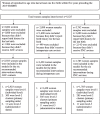Women's utilisation of quality antenatal care, intrapartum care and postnatal care services in Ethiopia: a population-based study using the demographic and health survey data
- PMID: 37337146
- PMCID: PMC10278283
- DOI: 10.1186/s12889-023-15938-8
Women's utilisation of quality antenatal care, intrapartum care and postnatal care services in Ethiopia: a population-based study using the demographic and health survey data
Abstract
Objective: This study sought to investigate the level and determinants of receiving quality antenatal care (ANC), intrapartum care, and postnatal care (PNC) services by women in Ethiopia. The quality of care a woman receives during ANC, intrapartum care, and PNC services affects the health of the woman and her child and her likelihood of seeking care in the future.
Methods: Data from the nationally representative Ethiopia Mini Demographic and Health Survey 2019 were analysed for 5,527 mothers who gave birth within five years preceding the survey. We defined quality ANC as having: blood pressure measurement, urine and blood tests, informed of danger signs, iron supplementation, and nutritional counselling during ANC services; quality intrapartum care as having: a health facility birth, skilled birth assistance, and a newborn put to the breast within one hour of birth during intrapartum care services; and quality PNC as having: PNC within two days; cord examination; temperature measurement, and counselling on danger signs and breastfeeding of the newborn; and healthcare provider's observation of breastfeeding during PNC services. We used multilevel mixed-effects logistic regression analyses specifying three-level models: a woman/household, a cluster, and an administrative region to determine predictors of each care quality. The analyses employed sampling weights and were adjusted for sampling design.
Results: Thirty-six percent (n = 1,048), 43% (n = 1,485), and 21% (n = 374) women received quality ANC, intrapartum care and PNC services, respectively. Private healthcare facilities provided higher-quality ANC and PNC but poor-quality intrapartum care, compared to public health facilities. Having four or more ANC visits, commencing ANC during the first trimester, and higher women's education levels and household wealth indices were positive predictors of quality ANC use. Government health posts were less likely to provide quality ANC. Wealthier, urban-residing women with education and four or more ANC contacts were more likely to receive quality intrapartum care. Women who received quality ANC and skilled birth assistance were more likely to receive quality PNC. Teenage mothers were more likely to receive quality intrapartum care, but were less likely to receive quality PNC than mothers aged 20-49.
Conclusions: We recommend standardizing the contents of ANC provided in all healthcare facilities; and promoting early and four or more ANC contacts, effectiveness, sensitivity and vigilance of care provided to teenage mothers, and women's education and economic empowerment.
Keywords: Antenatal care; Ethiopia; Intrapartum care; Maternal health; Postnatal care; Quality of care.
© 2023. The Author(s).
Conflict of interest statement
The authors declare that they have no competing interests.
Figures




Similar articles
-
Trends and inequalities in women's use of quality antenatal care, intrapartum care, and immediate postnatal care services in Ethiopia: multivariate decomposition, secondary data analyses of four demographic and health surveys over two decades (2001-2019).BMJ Open. 2025 Mar 28;15(3):e099309. doi: 10.1136/bmjopen-2025-099309. BMJ Open. 2025. PMID: 40157737 Free PMC article.
-
Determinants of maternal health service utilization in Ethiopia: analysis of the 2011 Ethiopian Demographic and Health Survey.BMC Pregnancy Childbirth. 2014 May 7;14:161. doi: 10.1186/1471-2393-14-161. BMC Pregnancy Childbirth. 2014. PMID: 24886529 Free PMC article.
-
Timing of first antenatal care visits and number of items of antenatal care contents received and associated factors in Ethiopia: multilevel mixed effects analysis.Reprod Health. 2021 Nov 17;18(1):233. doi: 10.1186/s12978-021-01275-9. Reprod Health. 2021. PMID: 34789283 Free PMC article.
-
Community mobilization to strengthen support for appropriate and timely use of antenatal and postnatal care: A review of reviews.J Glob Health. 2021 Dec 30;11:04076. doi: 10.7189/jogh.11.04076. eCollection 2021. J Glob Health. 2021. PMID: 35003714 Free PMC article. Review.
-
Inequities in utilization of reproductive and maternal health services in Ethiopia.Int J Equity Health. 2017 Jun 19;16(1):105. doi: 10.1186/s12939-017-0602-2. Int J Equity Health. 2017. PMID: 28629358 Free PMC article. Review.
Cited by
-
Multilevel analysis of quality of intrapartum care and its associated factors: evidence from 35 Sub-Saharan African countries demographic and health survey.Contracept Reprod Med. 2025 Feb 24;10(1):14. doi: 10.1186/s40834-025-00345-8. Contracept Reprod Med. 2025. PMID: 39994807 Free PMC article.
-
Sufficiency and consistency of antenatal care services in Ethiopia: Evidence from Mini Ethiopian demographic and health survey.PLoS One. 2025 Jun 6;20(6):e0319291. doi: 10.1371/journal.pone.0319291. eCollection 2025. PLoS One. 2025. PMID: 40478835 Free PMC article.
-
Perinatal depression and associated factors in Ethiopia: a systematic review and meta-analysis.BMC Psychiatry. 2024 Nov 19;24(1):822. doi: 10.1186/s12888-024-06246-5. BMC Psychiatry. 2024. PMID: 39563272 Free PMC article.
-
Assessment of antenatal care quality in Ethiopia: Facility-based study using service provision assessment data.PLoS One. 2025 Jan 16;20(1):e0313527. doi: 10.1371/journal.pone.0313527. eCollection 2025. PLoS One. 2025. PMID: 39820615 Free PMC article.
-
Receipt of adequate antenatal care and associated factors among women delivering in public hospitals, Afar region, Ethiopia.Sci Rep. 2025 Aug 9;15(1):29197. doi: 10.1038/s41598-025-10535-8. Sci Rep. 2025. PMID: 40783497 Free PMC article.
References
-
- World Health Organization: Standards for improving quality of maternal and newborn care in health facilities. https://www.who.int/publications/i/item/9789241511216. 2016.
-
- Ethiopian Public Health Institute-Public Health Emergency Management Center (PHEM): Ethiopia - National Maternal Death Surveillance and Response System Annual Report 2010 Ethiopian Fiscal Year. https://www.afro.who.int/publications/ethiopia-national-maternal-death-s.... 2019.
-
- The Harvard Chan School Centre of Excellence in Maternal and Child Health: Quality of Maternal Health Care. Maternal Health Task Force. 2021. https://www.mhtf.org/topics/quality-of-maternal-health-care/. Accessed 24 Aug 2021.
MeSH terms
LinkOut - more resources
Full Text Sources
Medical

